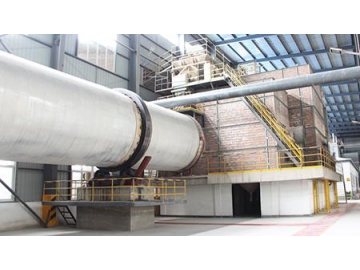Calcining and Drying Units
Calcination is the key process of the production, and the most difficult process.
The conversion of dihydrate gypsum to hemihydrate gypsum is performed on gypsum powder in this process.
Drying and dehydration is the key and most difficult part of the process. We offer 2 new types of calcining: boiling furnace calcining and pot calcining.
The boiling furnace is hot air type, divided into a main furnace and an attached furnace;
A high-pressure Roots blower is set at the bottom, blowing hot air in to help boiling the powder inside the furnace.
Powder does heat exchange with hot air. Hot air transfers heat to powder and get it calcined.
Powder firstly enters main furnace, get calcined, then enter the attached furnace through the tunnel in the bottom for further dehydration, finally get discharged into screw conveyor through the discharge port on the top. Steam generated by calcination and air blown by Roots blower at the bottom get discharged through the top of the boiling furnace and enter the dust collector. Waste gas get cleaned by the dust collector and then discharged to the atmosphere as clean air.
Besides calcining natural gypsum, the system is also suitable for calcining synthetic gypsum such as desulfurization gypsum, phosphor gypsum, etc.
- Simple structure, uneasy to damage; vertical design with compact size, room-saving.
- Low-temperature heat source is applied, to prevent gypsum from getting over heated, by controlling discharge temperature, except a small amount of dihydrate and anhydrite gypsum, the major containment of the finished product is hemihydrate gypsum, which is an ideal condition with stable physical performance.
- Energy saving, over 95% high thermal efficiency, very low energy loss.
- Low electric energy consumption: boiling furnace does not rotate, and there is no mixer to consume electric power. Material is fluidized by steam generated by gypsum dehydration process, therefore little electric power is needed, and therefore electric energy consumption of the boiling furnace calcining system is much lower than traditional calcining devices.
Vertical pot calcining system takes hot flue gas for heat transferring, transfers heat inside the pot by pot bottom and fire tube inside, doing heat exchange with powder inside. A mixing device with stirring fins is deployed to make a more even heating process.
Besides natural gypsum, the system is also suitable for calcining synthetic gypsum such as desulfurization gypsum, phosphor gypsum, etc.
- Energy-saving, the pot is closed with fire-proof material on the outside; when waste gas get discharged after cleaning by dust remover, its temperature is only around 90℃.
- Its products are highly qualified.
This system performs a low-temperature slow calcining process, able for both continuous and discontinuous production, suitable for various needs.
Dust removing system applies a bag dust remover, to remove dust generated in the production processes, clean the waste gas to prevent pollution.
Serve as heat source for calcining system.
Take hot flue gas generated by burning as heat transferring medium, send it directly into calcining device. Hot flue gas does heat exchange with powder via calcining system to calcine the gypsum powder. Air heat using gas is easy for temperature adjustment, outlet temperature is controlled within ±10℃. Air heater is effective in the production.
Fuel: heavy oil (diesel, petroleum, etc.), light oil, coal, biomass, natural gas, etc.
Heat Transfer Medium: hot air, conduction oil.
